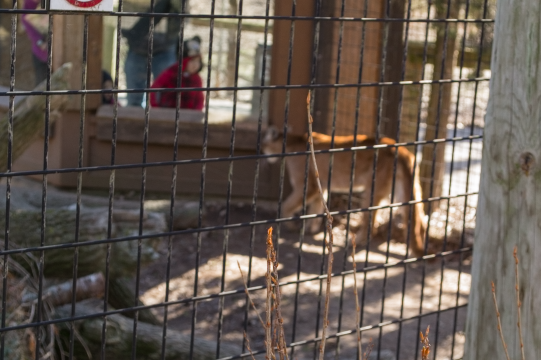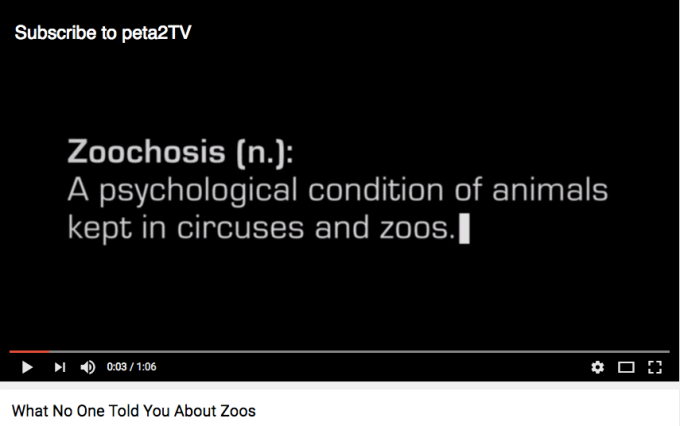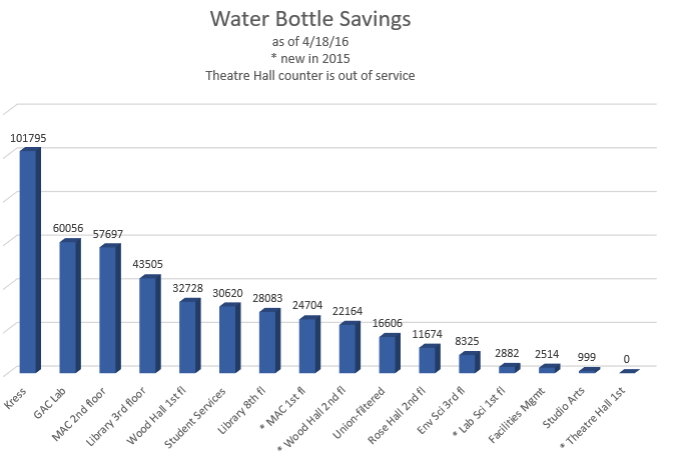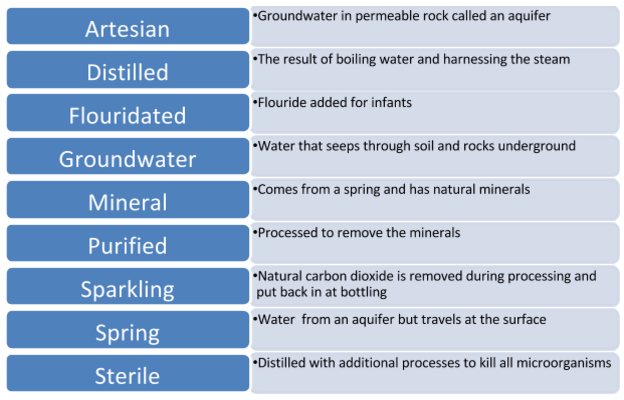By Jule-Sophie Hermann, Kaitlyn Hein, Sarah Seifert, Troy Williams, and Sam Dunkovich
GREEN BAY, WISCONSIN – The mountain lion has been pacing for over an hour.

Sarah Seifert/The Avenue
Her name is Avani, and she is a permanent resident of Green Bay’s Bay Beach Wildlife Sanctuary. A worn wooden sign hangs next to a smudged window overlooking her enclosure, informing guests that she is an orphan of a small county in Oregon, and cannot be returned to the wild because she has imprinted on a human. Next door, two foxes bask in the late afternoon sun, sometimes taking lazy swipes at each other’s tails, but mostly drowsing, looking bored.
Avani still paces. It takes her twenty-two seconds to make a full circuit around her enclosure. She pays special attention to the fence that divides her from the foxes, and ignores the group of shrill children eagerly waving to get her attention. A nearby adult hushes them, whispering that they needed to be respectful, that the cougar might get upset if they yell too loudly.
This narrow divide between predator and prey is as controversial as it is fascinating. Although cougars might not commonly catch and eat foxes in the wild, they will eat almost any small mammal, so the predator-prey relationship here is not a stretch. Zoos often have to consider this dichotomy when building their exhibits – Gen Bando, director of Japan’s popular Asahiyama Zoo, said in a 2010 interview with the Japan Times that the zoo’s timber wolves and sika deer share a fence – deliberately. “The animals know the fence is there and that the animal on the other side can’t come any closer, but there is a degree of tension in the relationship,” Bando said. He goes on to explain that the closeness is meant to instill fear for the wolves in the sika deer, to mimic that instinct you might find in wild deer.

One of the Sanctuary’s adolescent wolves naps after feeding time. Sarah Seifert/The Avenue
The Wildlife Sanctuary’s wolves and coyotes, on the other hand, are curiously isolated from the rest of the animal exhibits. The adolescent wolves are currently sleeping in their sprawling, multi-acre run, complete with a huge glass observation window, chain-link fence, and a wooden rail separating human from beast. The two coyotes have a smaller, but respectable enclosure, shaded by old oaks and maples.

One of the Sanctuary’s non-exotic residents. Sarah Seifert/The Avenue
This is Green Bay’s largest animal refuge at approximately 600 acres. The area’s other animal exhibit, the NEW Zoo, is just a fifteen-minute drive away in quiet, wooded Suamico. It presents a more traditional zoo experience; the exhibits are interspersed with playgrounds and twee animal-fact stations. Its most popular exhibit is by far the Giraffe Feeding Experience, according to Education and Volunteer Programs Coordinator Angela Kawski-Kroening. She calls it “a wonderful way for visitors to interact with and get up-close and personal with the animals.” Many of their visitors agree. The NEW Zoo’s social media reviews are solid; their official Facebook page has been reviewed over 3,000 times, with an average rating of 4.5 stars out of 5. “When you visit, the exceptional care of the animals and the grounds is obvious,” one Facebook reviewer says.
Animal deaths at NEW Zoo raise questions
However, the NEW Zoo has seen several animal deaths in the past few years. Most notably, in June of 2016 the Green Bay Press-Gazette reported that three of the zoo’s river otters, a young mother and two pups, had died suddenly of a salmonella infection. The pups were part of the first litter born at the zoo, according to the Press-Gazette’s Doug Schneider.
Four months later in October, the zoo’s resident moose also passed away unexpectedly. ‘Finnegan’ was about eight years old and reportedly suffered from respiratory issues, and according to the Press-Gazette, NEW Zoo’s animal curator confirmed that an eight-year lifespan is not out of the ordinary for moose. According to National Geographic, the average lifespan of a moose in the wild is 15-20 years.
A potential member of the zoo’s beloved giraffe-feeding program passed away years earlier, in 2013, Green Bay’s local CBS affiliate reported. A young calf was born, but passed away about three days later due to feeding complications. According to the zoo, it was the second unsuccessful birth for the mother, and young calves often died when unable to nurse on their own.
The Bay Beach Wildlife Sanctuary has experienced its own share of tragic animal death. In 2017, a bald eagle, found in a park in nearby Kaukana, was brought to the sanctuary and despite overnight care by the staff, died due to lead poisoning.
It’s unfair to compare the NEW Zoo and the Sanctuary based on animal care expectations; one is a traditional exhibit structure, and the other is focused more on education and conservation. One actively rehabilitates animals, and the other does not. “We are not a rescue/rehab facility, so we cannot and do not take animals out of the wild to rehab them. We are only able to accept a ‘rescue’ animal after it has been successfully rehabbed by another facility, and only if it can’t be released into the wild and only if we have an appropriate space/need for that animal,” says Kawski-Kroening.
But there is an obvious overlap: animals are kept in enclosures in both spaces. How can visitors be sure that these organizations are keeping the animals safe, healthy, and content? Is one structure inherently more harmful than the other?
Controversy over zoo structure and ethics
According to CaptiveAnimals.org, presenting animals to zoo visitors as living exhibits teaches children that animals can be manipulated to fulfill a minute curiosity. “It fails to recognize that animals have their own needs to be met,” the site says. “It suggests that animals have no right to be treated as individuals who think and feel for themselves.” The controversy surrounding zoos is long and complicated. There are many advocates who strongly believe that the educational aspects far outweigh the miniature enclosures and hazardous living conditions. However, in recent years Zoos and animal sanctuaries have come under fire for the psychotic and abnormal behaviors of their captive wildlife. These issues are often times referred to as zoochosis.
Wildlife New Zealand says that “Zoochosis is the term used to describe the stereotypical behavior of animals in captivity.” It is believed that stereotypic behavior is defined as repetitive, invariant behavior with no obvious goal or function. These actions are not seen in animals in the wild and is understood to be abnormal by leading animal experts worldwide.

Zoochosis, a video produced by People for the Ethical Treatment of Animals (PETA).
According to an article by Justin Worland published by Time Magazine earlier this year, “Study after study has shown that many animal species are far smarter and more feeling than previously understood…” This may suggest that there is a higher possibility that animals removed from their natural habitat will eventually experience depression and anxiety.
There are many different levels of captivity throughout the world, but two in Green Bay specifically; the NEW Zoo and the Bay Beach Wildlife Sanctuary both house exotic and native animals. Is a ‘sanctuary’ more educational for the community, more ethical for animals’ happiness, than a zoo? Or would sacrificing the education value of these exhibits to make sure the animals live full, healthy lives be the more ethical choice?
The NEW Zoo and Adventure Park of Green Bay’s mission is to “connect the community with wildlife and nature through engaging, interactive experiences.” It must be asked, however, is the zoo meeting these goals? And, where does the well-being of their animals fall into their mission?
In January 2017, through a collaboration with the surrounding Brown County Reforestation Camp, the New Zoo & Adventure park released a plan to achieve said mission. According to the Zoo’s website, its Master Plan, developed over a six month planning process, will come to fruition over the next two decades. The Master Plan will reportedly include guest attractions and accommodations, recreational activities, and expanding or relocation of animal exhibits.
The NEW Zoo’s proposed plans for construction on animal enclosures. Image courtesy of the NEW Zoo.
Where does animal welfare and health fall into the NEW Zoo’s proposed plans? It is the fifth and last item on the Master Plan’s Executive Summary: “[To] exemplify the highest standards of animal care and foster a connection to conservation in all experiences, programs and partnerships.”
The rest of the Master Plan’s goal categories for 2017-2021 include internal relations, operations, and budget, being topped off with “Guest Experience.”
The proposed Master Plan includes a far-reaching budgetary schedule with estimated costs to be at least $30 million over 10 to 20 years. Relocation of animals and construction to enclosures encompasses around $17 million in expenses. Other projects include guest attractions and accommodations such as a water park, an overhead tree top course, and expansion to parking.
The NEW Zoo’s proposed plans for parking expansion and a tree top concourse. Image courtesy of the NEW Zoo.
Though the Zoo lists animal care among its core values and top goals, the Master Plan also shows that the New Zoo is quite a small portion of what the plan has in store. The map below shows the area of the Zoo (outlined in black at the center) in relation to the Brown County Reforestation Camp.
With zoo psychosis among the top issues facing animals in captivity, is lack of space is a contributing factor? According to the Captive Wildlife Pen Specifications & Transport Standards document, released by the Wisconsin Department of Natural Resources (DNR), “Pens must be large enough to allow each captive wild animal to make normal position changes.” Because there are no exact specifications for pen size in Wisconsin Zoos, the size can vary among locations. However, enough room for normal position changes seems to diverge greatly from the animal’s natural habitats.
The DNR also states that “pens need to be cleaned at least every 2 weeks.” This, among other requirements, do not seem to have the animals’ well-being in mind, and seem to ignore the need for proper care. Also, the last these regulations were updated was in 2003, 14 years ago. It seems strange that even with the call for higher animal rights, our state has not increased regulatory requirements in over a decade.
According to GlobalAnimal.org, “Despite a zoo’s best efforts, its animals often are deprived of privacy, confined to inadequate spaces and unable to engage in natural hunting and mating activities.” Recent events have brought this idea to the minds of many. With the recent death of Tilikum, a captive orca at Seaworld responsible for the death of one trainer, and the injuries of various others, many are starting to diverge from the belief that ‘education’ is the sole purpose of animal captivity.
However, many still argue that captivity is a way to conserve and assist endangered species. Zoo.org, argues that zoos have many positives including increased population growth while providing a visual, and educational experience for all.
This leads us to the perspective of the zookeepers. Many argue that their work is focused and dedicated to care for the animals and form deep relationships with them, thus, improving their lives. A word that is often used here, as mentioned before, is conservation, defined by Worland as “the work of protecting endangered species”. In zoos, many endangered species are born in captivity, and would therefore never be able to survive in the wilderness. They will inevitably live in the zoo forever, for their own safety.
In some cases, researchers have tried to pair endangered species from the Zoo with wild animals of that species, like the Pinta Island giant tortoise. Although this particular example failed to succeed, according to the Association of Zoos and Aquariums (AZA), many zoos are currently helping the organization to conserve species such as the african penguin, the cheetah, and gorilla, and the asian elephant. Adding to that, AZA reports that over thirty species have escaped the threat of extinction thanks to the work of zoos and aquarium. Over 600 species are currently under a survival plan. Zoos and aquariums working with the AZA spent approximately $160 million yearly on conservation programs. Among the zoos that are currently accredited by the AZA is the NEW Zoo in Green Bay.
According to Worland’s Time article, many zoos have also expanded their take on conservation. “Instead of saving a species, some argue, they advance conservation work by education patrons and pushing them to donate to the cause”, Worland writes. The connection to climate change and endangered species is another way to approach conservation. However, it is important that everything in the zoo is somehow connected to the wilderness. People who donate must have the feeling of being directly a part of the conservation process.
The diverging beliefs of many will continue to guide this issue forward. But, the future of zoos and captive animals remains unclear. Worland highlights a concept he describes as the “unzoo”. It involves bringing the animals to people, not people to the animals. Instead of space to stroll around and explore for humans, it gives animals the space to walk around freely, while the humans watch from an enclosure. A safari-like experience, if you will.
But there is one problem: money. Many zoos will not be able to afford this kind of change to their exhibits. Such a transformation would call for fundings most zoos would have a hard time collecting. However, zoo owners and designers alike are aware of the growing criticism and skepticism the public is showing towards animal captivity. If this trend continues to grow, every zoo will be required to revise and transform their exhibits in order to stay sustainable.
What does the public think? We asked students, faculty, and community members in Green Bay what their thoughts on zoos, wildlife “sanctuaries,” and animal exhibit legislation. Their opinions and experiences range from the enthusiastically positive to the firm thumbs-down.
As a society, we are uncertain how to approach such issues. Do we continue rebuilding endangered species, or do we strive to take better care of our planet so their numbers can grow naturally? Is sacrificing the happiness of a few animals to educate our youth worth it, so the species as a whole can be protected and loved?







 To put this theory to the test, six First Alert drinking water test kits were purchased. They test to Environmental Protection Agency (EPA) standards for bacteria, lead, pesticides, nitrates, nitrites, chlorine, hardness, and pH. Water samples were gathered from Aquafina bottled water from one of the vending machines on campus, MAC hall across from Marie’s vending area, Common Grounds coffee shop tap water, filtered water from the hydration station in the Student Union, well water, and the campus tap water run through a Brita water filter.
To put this theory to the test, six First Alert drinking water test kits were purchased. They test to Environmental Protection Agency (EPA) standards for bacteria, lead, pesticides, nitrates, nitrites, chlorine, hardness, and pH. Water samples were gathered from Aquafina bottled water from one of the vending machines on campus, MAC hall across from Marie’s vending area, Common Grounds coffee shop tap water, filtered water from the hydration station in the Student Union, well water, and the campus tap water run through a Brita water filter.






